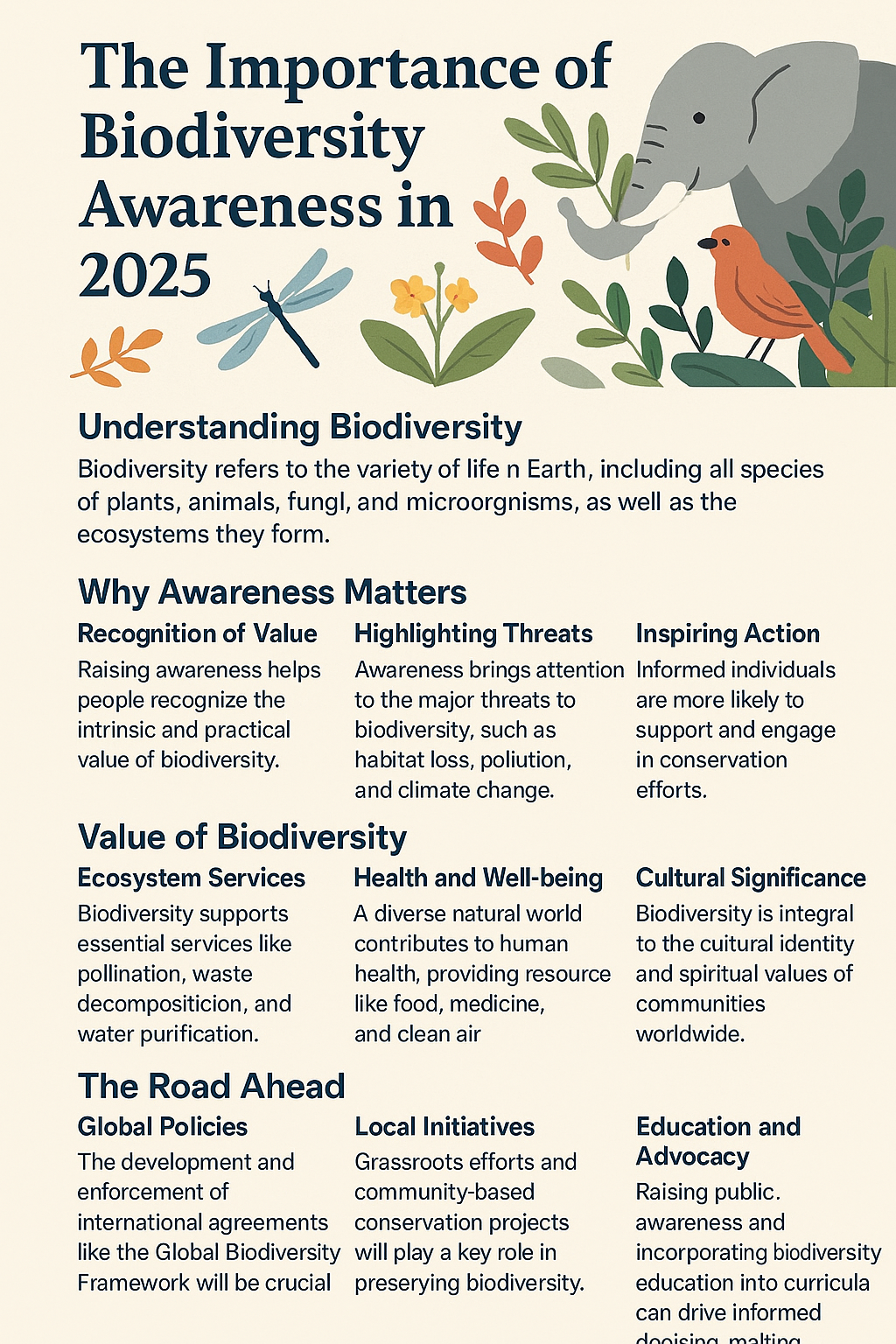
As we navigate the challenges of climate change, habitat destruction, and a rapidly shifting global economy, the year 2025 marks a pivotal moment in our relationship with the natural world. Biodiversity—the vast variety of life forms on Earth—has never been more crucial to protect. From the air we breathe to the food we eat and the medicines that heal us, biodiversity is the foundation of human survival. Yet, despite its importance, we continue to witness an alarming decline in species, ecosystems, and genetic diversity across the planet.
Raising awareness about biodiversity is not just the responsibility of scientists, conservationists, or policymakers—it’s something we all must take part in. In this blog, we’ll explore why biodiversity matters, what threats it faces today, and how awareness and action in 2025 can shape a sustainable future.
What Is Biodiversity?
Biodiversity refers to the variety of living organisms in a particular habitat or ecosystem. It includes species diversity (the number of different species), genetic diversity (variation within species), and ecosystem diversity (the range of different habitats).
Healthy ecosystems are biodiverse. They provide services that humans often take for granted:
-
Clean air and water
-
Pollination of crops
-
Climate regulation
-
Natural disease control
-
Cultural and spiritual value
In short, biodiversity isn’t just a luxury of nature—it’s essential to life.
The State of Biodiversity in 2025
Despite growing global conversations around sustainability, the loss of biodiversity has accelerated in recent years. According to the UN’s Global Biodiversity Outlook report, nearly 1 million species are at risk of extinction. The drivers of this crisis are familiar but no less urgent:
-
Habitat destruction through deforestation, urban sprawl, and industrial agriculture.
-
Pollution from plastics, pesticides, and other toxins that disrupt ecosystems.
-
Overexploitation of species for food, medicine, or the exotic pet trade.
-
Climate change, which is rapidly altering the natural balance.
-
Invasive species introduced by global trade and travel.
In 2025, these trends continue to place pressure on fragile ecosystems—especially in biodiversity hotspots such as the Amazon Rainforest, the Congo Basin, and coral reefs in the Pacific.
Why Awareness Matters More Than Ever
So why focus on awareness? Because awareness leads to understanding, and understanding leads to action.
-
Public Policy Influence When citizens are educated about biodiversity, they’re more likely to support policies that protect it. Whether it’s voting for green legislation, attending public hearings, or supporting environmental NGOs, awareness is the first step.
-
Corporate Accountability Consumers have more power than ever. Informed consumers can pressure companies to adopt sustainable practices—from sourcing to packaging. In 2025, businesses that ignore biodiversity risk damaging their brand.
-
Community Engagement Biodiversity awareness at the local level can drive initiatives like tree planting, community gardens, or local wildlife protection. These grassroots actions are scalable and deeply impactful.
-
Youth Involvement The new generation is leading the charge. From school-led conservation clubs to youth climate strikes, young people are embracing environmental stewardship—and awareness is their starting point.
Biodiversity and the Economy
Nature’s services are worth trillions annually. The World Economic Forum estimates that over $44 trillion of global economic value—more than half of global GDP—is moderately or highly dependent on nature. In 2025, industries such as agriculture, fishing, tourism, and pharmaceuticals are beginning to realize that their futures depend on ecosystem health.
-
Farming relies on pollinators like bees.
-
Fisheries depend on balanced marine food webs.
-
Tourism thrives on natural beauty and wildlife.
-
Biotechnology looks to nature for genetic resources.
Without biodiversity, these sectors would suffer catastrophic losses. Raising awareness helps bridge the gap between ecology and economy.
Technology and Biodiversity in 2025
Technology is playing a growing role in biodiversity conservation:
-
AI and drones help monitor wildlife populations in real time.
-
Citizen science apps let everyday people contribute to research.
-
DNA barcoding helps identify species quickly and protect endangered ones.
-
Blockchain helps track sustainable supply chains in agriculture and seafood.
As tech becomes more embedded in conservation, it becomes more important for the public to understand and support these efforts. Once again, awareness becomes the driver of change.
How You Can Promote Biodiversity Awareness
Even if you’re not an environmental scientist, you can make a difference:
-
Educate Yourself and Others Read about local species, ecosystems, and conservation challenges. Share articles, videos, or even this blog to keep the conversation going.
-
Support Biodiverse Habitats Plant native species in your yard, avoid harmful pesticides, and advocate for green spaces in your community.
-
Reduce Your Ecological Footprint Eat sustainably (less meat, more plants), use eco-friendly products, and minimize waste.
-
Get Involved Join conservation groups, participate in clean-ups, or volunteer at local nature centers.
-
Speak Up Use your voice on social media, at town halls, or in the voting booth to advocate for biodiversity protection.
Looking Ahead
The fight to preserve biodiversity is far from over, but 2025 is a crucial year. The global community is more connected, informed, and empowered than ever before. Governments are negotiating new frameworks under the Convention on Biological Diversity. Schools are adopting biodiversity into their curriculum. Startups are building technologies that protect ecosystems. And citizens around the world are realizing that biodiversity isn’t an abstract issue—it’s our issue.
Raising awareness is the first and most important step toward systemic change. When people understand the value of biodiversity, they are more likely to act, support, and protect it.
Let 2025 be the year we move from awareness to action—because our future depends on it.


